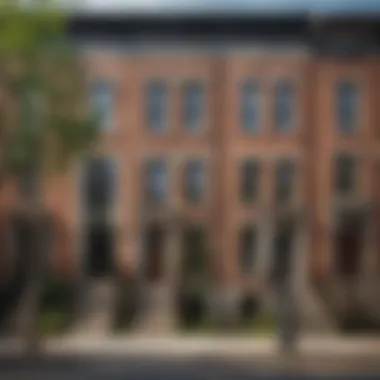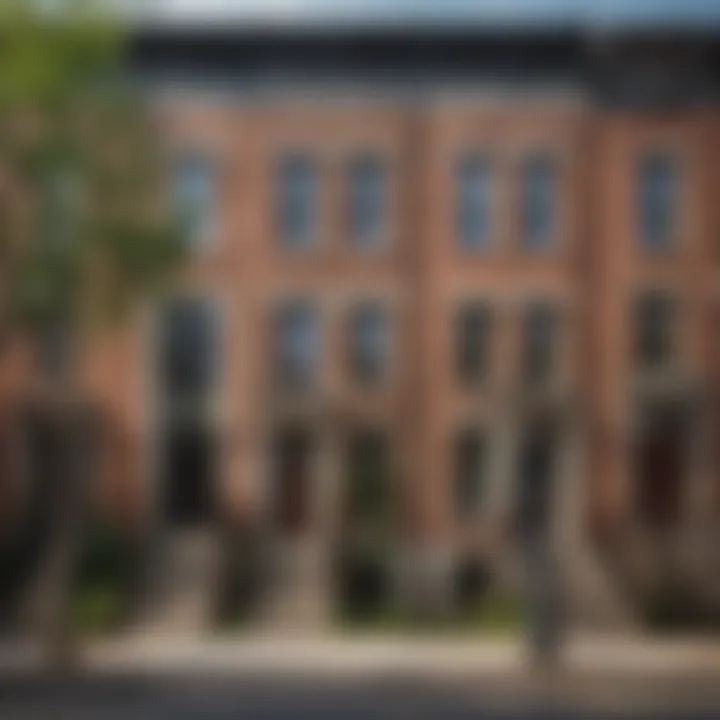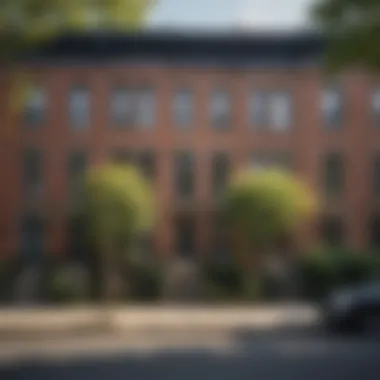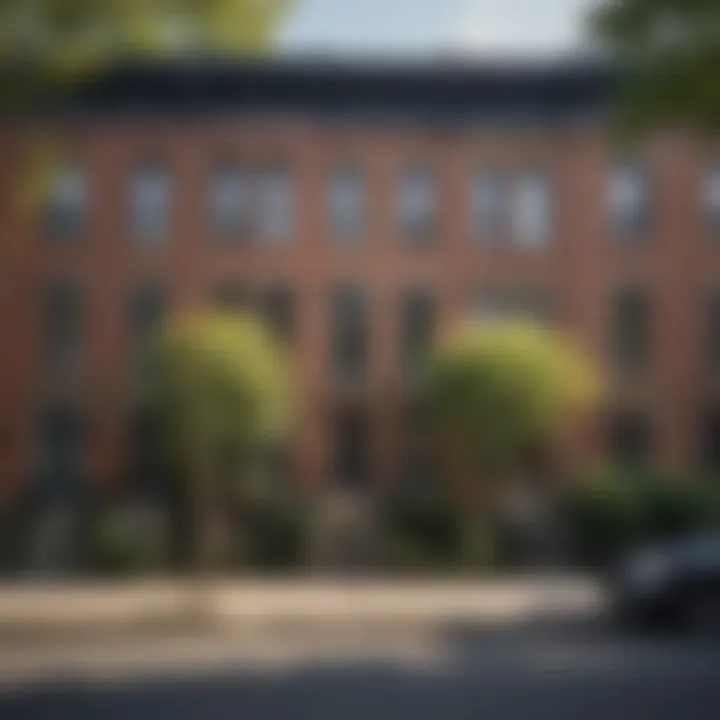Exploring Washington DC Row Houses for Rent: A Guide


Intro
The rental market in Washington, D.C. is unique in many ways, particularly when it comes to row houses. These structures, with their rich history and distinct architectural style, offer more than just a place to live. For potential renters, understanding the nuances of this market is essential. This guide aims to illuminate the various aspects of renting a row house in D.C., addressing key considerations that should influence rental choices.
From historical context to current market trends, this exploration provides valuable insights for both newcomers and experienced renters. With the hope of fostering informed decisions, we delve into the architectural elements that make row houses appealing. We will also touch on aspects related to interior design, as how one chooses to decorate a space can significantly affect their living experience.
Let's dissect the charm and subtleties of row houses in Washington, D.C.
Intro to Row Houses
Row houses represent a distinct form of architecture that is significant in urban living. In Washington, D.C., these structures offer not just housing but a lifestyle choice that resonates with many. Understanding row houses is essential for anyone interested in the local real estate market. This section introduces the reader to the concept of row houses, their unique characteristics, and the reasons why they are appealing to renters.
Definition of Row Houses
Row houses are essentially a series of attached homes that share walls on either side. Each unit typically appears as a single-family home but is part of a continuous row. This design promotes efficient use of land and encourages the development of close-knit communities. The architecture is often characterized by uniform facades, similar heights, and aligned entrances. The interiors vary, offering different layouts and sizes to meet various living needs.
Historical Significance in
In Washington, D.C., row houses have a rich history dating back to the 19th century. They emerged during a period of urbanization when the city was expanding. The design allowed for maximum density while maintaining the aesthetic appeal of residential areas. Many of these houses showcase beautiful craftsmanship, often featuring elaborate brickwork and ornate details.
The historical significance of row houses lies not just in their architectural value but also in their contribution to the social fabric of neighborhoods. They have housed generations of residents, fostering a sense of community. In recent years, there has been a revival of interest in these homes, driven by both their legacy and their practicality in modern urban life.
The Architectural Appeal of Row Houses
Row houses represent a unique architectural vision that captures the essence of urban living, particularly in Washington, D.C. Understanding their appeal is crucial for potential renters who seek both charm and practicality. These homes portray a blend of history and style, which draws in numerous individuals looking to immerse themselves in the rich culture of the city. The allure of row houses lies in their cohesive aesthetic, convenient location, and the vibrant communities they foster.
Distinct Features
One cannot overlook the specific characteristics that make row houses stand out.
- Uniform Design: Most row houses showcase similar facades aligning perfectly along the street. This offers a sense of order and elegance that is pleasing to the eye.
- Victorian Elements: Many structures incorporate Victorian architectural features such as decorative trim and bay windows. Residents find these details captivating and indicative of the city's historical roots.
- Intimate Layouts: Generally, row houses maximize space efficiency. They typically feature multi-level designs that provide a variety of living arrangements, accommodating families, young renters, or professionals.
The harmonious designs encourage a community-oriented lifestyle. Homeowners often take pride in maintaining their front gardens, which adds life to the neighborhood.
Notable Row House Styles
D.C. is home to various styles of row houses, each showcasing its unique charm.
- Federal Style: Recognized for its symmetrical façade and simple, yet elegant trim, the Federal style emphasizes classic beauty.
- Victorian Style: This category embraces colorful exteriors with elaborately detailed cast iron and woodwork features. Many find pleasure in the individuality of each unit within this style.
- Colonial Revival: This style gained popularity in the early 20th century, marked by its attention to detail and classical proportions. Colonial revival row houses often feature columns and iconic rooflines.
It's worth noting that each style allows renters to find something that resonates with their personal aesthetic preferences while enjoying the benefits of residing in close proximity to others.
"Row houses exemplify the architectural diversity of D.C., embodying the city’s history and community spirit."
In summary, the architectural appeal of row houses enriches the rental experience in Washington, D.C. Understanding these features and styles can help potential renters choose a home that best suits their tastes and lifestyle needs.
Understanding the Rental Market
The rental market for row houses in Washington, D.C. is a multifaceted environment that requires careful examination. Understanding this market is crucial for both prospective renters and property owners. It allows individuals to make informed decisions based on current dynamics, helping them navigate the intricacies of leasing residential properties in a historical and architecturally rich city. An awareness of market trends, prices, and influencing factors can significantly enhance the renting experience.
Current Market Trends
Currently, the rental market for row houses in D.C. is experiencing interesting shifts. Factors such as urban development and changes in demographic preferences are playing a significant role. In recent years, there has been a notable preference for urban living, leading to increased demand for row house rentals. Neighborhoods with rich histories, like Georgetown and Capitol Hill, are particularly attractive.
Rent prices are generally influenced by location, amenities, and house conditions, which are essential aspects for potential renters to keep in mind. Moreover, as remote work becomes more common, some renters are opting for larger spaces within row houses, thus marking a shift in demand. According to recent statistics, listings for row houses have seen quicker turnover rates compared to other types of rental properties.
Average Rental Prices
When it comes to average rental prices, row houses in Washington, D.C. typically command a premium due to their unique appeal and historical significance. Generally, a two-bedroom row house in a desirable neighborhood may range between $2,500 and $4,000 per month. In high-demand areas, such as Logan Circle, prices may escalate even higher.


Prospective tenants should be aware that prices can vary greatly depending on specific factors such as:
- Location
- Square footage
- Availability of outdoor space
- Proximity to public transport
It’s important for renters to conduct thorough financial assessments to determine what they can afford without overextending their budgets.
Factors Affecting Pricing
Several factors come into play when determining the rental prices for row houses:
- Supply and Demand: The availability of row houses relative to the number of potential renters significantly impacts prices. A low supply with high demand can drive prices up.
- Seasonality: Rental prices may fluctuate with the seasons. Often, the spring and summer months see increased listings resulting in varying rental prices.
- Property Condition: Well-maintained properties with updated amenities usually attract higher rental prices. Tenants should carefully check the overall condition of the row house before committing.
- Neighborhood Characteristics: Safety, school districts, and proximity to shops or parks can contribute to the desirability of an area.
Understanding these factors is essential for renters to ensure they are making a sound investment in their living situation.
"The heart of Washington D.C. lies in its neighborhoods, and the right row house can offer both a home and a lifestyle rich in culture and history."
Proactive research and market awareness can greatly influence the outcome of your renting journey in D.C.
Benefits of Renting a Row House
Renting a row house in Washington, D.C. comes with a range of benefits that cater to diverse lifestyles. This section explores the significant advantages offered by these homes, which combine community, convenience, and efficient living spaces. Whether you're a young professional, a family, or someone looking to immerse in city life, understanding these benefits can help you make an informed decision.
Community Living
Row houses promote a sense of community. Living close to neighbors can foster relationships and create a supportive environment. Typically, row houses are found in established neighborhoods with shared values and pride in their area. This proximity encourages social interaction. You might find yourself attending block parties or simply chatting with a neighbor while gardening.
In addition, many row houses are part of historical districts, which often have a strong community focus. Frequent community events can lead to a deeper connection among residents. The preservation of these homes also reflects the community’s commitment to maintaining its character and charm, creating a unique living experience.
Proximity to Amenities
The locations of row houses in D.C. are strategically selected to maximize access to amenities. These homes are often near public transportation, grocery stores, parks, and restaurants. For instance, living in neighborhoods like Capitol Hill or Georgetown provides easy access to cultural venues, shopping districts, and vibrant social scenes.
For those who prefer a more relaxed lifestyle, row houses near parks or community centers offer green spaces for relaxation or outdoor activities. The convenience of nearby amenities enhances the quality of life, allowing residents to enjoy both leisure and essential services without the need for long commutes.
Space Efficiency
Another significant benefit of renting a row house is the efficient use of space. These homes are designed to offer multiple levels without occupying a large footprint. This vertical living style maximizes square footage, often incorporating layouts that include open floor plans, which allow for natural light and increased livability.
Many row houses also provide outdoor spaces like small yards or patios. This balance of indoor and outdoor areas gives residents the chance to enjoy personal space without the overwhelming upkeep of larger properties. Moreover, their historical designs often include built-in storage solutions that help maintain a clutter-free environment, making them incredibly attractive for those who prioritize functional living spaces.
"Row houses are not just homes; they reflect a unique lifestyle intertwined with community, culture, and convenience."
In summary, renting a row house in D.C. offers various benefits that align with modern living demands, making them appealing for renters seeking a balanced urban experience.
The Rental Process for Row Houses
The rental process for row houses is a critical aspect of finding your next home in Washington, D.C. It is essential to approach this process with knowledge and awareness. A thorough understanding can make the difference between securing a dream apartment or getting caught in a binding lease that does not meet your needs. Understanding how to navigate this process helps both new and seasoned renters optimize their search and ultimately make informed decisions.
Finding the Right Row House
Finding the right row house is more than just browsing listings online. It is about matching your preferences with the specific features that the property offers. Consider the following factors:
- Location: Identify neighborhoods that suit your lifestyle. Proximity to work, public transport, and available amenities plays an important role.
- Size and Layout: Think about your space needs. Row houses come in various sizes, so ensure you find a layout that fits comfortably.
- Condition of the Property: Look for properties that have been recently updated but also consider the potential upkeep with older builds. Always check for any maintenance issues.
- Community Vibe: The character of the neighborhood can impact your living experience. Visit at different times to gauge the atmosphere.
While online platforms like Reddit can provide insights, it’s also advisable to consult local real estate agents who know the area well. They can offer a list of potential homes tailored to your requirements.
Understanding Lease Agreements
Once you find an appealing row house, the next step involves understanding the lease agreement. Leases can often be filled with jargon that may seem overwhelming. Here are some key points to consider:
- Terms of Lease: Identify the duration of the lease. Typical agreements range from one year to multiple years. Shorter leases can provide more flexibility.
- Renewal Clauses: Check if automatic renewals are included and understand your obligations for renewal notices.
- Maintenance Responsibilities: Clearly define who is responsible for maintenance. Some landlords may handle major repairs, while tenants manage minor ones.
- Alterations and Modifications: Many leases limit tenant modifications. Know your rights should you want to redecorate or improve the space.


Always take the time to read your lease carefully and ask questions if something isn’t clear. It's wise to consult a legal expert if there are terms that appear ambiguous or unfavorably skewed towards the landlord.
Dealing with Deposits and Fees
Dealing with deposits and fees can add another layer of complexity to the rental process. Understanding the costs involved requires careful attention to details:
- Security Deposits: Typically, security deposits can range from one to one and a half months’ rent. Become familiar with your rights concerning deposit return policies.
- Application Fees: Expect fees when applying for a rental. These fees can cover credit checks and administrative costs, but ensure they are reasonable and justified.
- Additional Fees: Some landlords may charge for utilities, parking, or maintenance services. Always clarify what is included in your rent to avoid surprises.
- Pet Deposits: If you have pets, many leases require additional deposits or fees. Familiarize yourself with pet policies to ensure they align with your situation.
Ultimately, clear communication with landlords and understanding your financial commitments are essential for a smooth rental experience.
The rental process will involve various considerations, from finding the right property to ensuring agreements are clear and fair. Knowledge is your best ally in navigating these waters.
Challenges of Renting Row Houses
Renting a row house in Washington, D.C. is an attractive option for many, but it comes with its own set of challenges. Understanding these hurdles is crucial for prospective tenants to navigate the rental landscape effectively. This section highlights maintenance responsibilities, noise and privacy concerns, and space limitations. Addressing these factors can lead to a more informed rental experience and ultimately enhance the value of living in a row house.
Maintenance Responsibilities
One notable aspect of renting a row house is the division of maintenance responsibilities. Unlike an apartment, where a landlord typically manages repairs and landscaping, row house tenants may have more direct involvement. Many landlords expect tenants to take care of basic repairs such as replacing light bulbs or troubleshooting minor plumbing issues.
Moreover, landscaping can fall on the tenant as well. If there is a front or backyard, responsibilities often include regular mowing, weeding, and other forms of upkeep. Therefore, it is crucial for renters to clarify these responsibilities before signing a lease.
Do not assume that traditional landlord-tenant norms apply in row houses. Ask detailed questions to avoid misunderstandings.
Noise and Privacy Concerns
Another challenge relates to noise and privacy. Row houses share walls with neighboring units, which can lead to elevated noise levels. Sounds from next door, whether it's television noise or footsteps, can disrupt your peace.
Privacy can similarly be compromised. Windows often face neighboring homes, leading to visibility into each other’s living spaces. Many renters find this less than ideal. Consideration of soundproofing measures or investing in heavier curtains may be necessary. Some dwellers even opt for additional sound insulation to mitigate these concerns.
Space Limitations
Lastly, space limitations are a significant consideration when renting a row house. The design typically maximizes the use of vertical space, which can make living areas feel compact. While row houses offer unique architectural beauty, this can lead to cramped conditions, especially for larger families.
Storage can be another issue. Many row houses have limited closet space, compelling renters to find storage solutions. This could involve utilizing attics, basements, or off-site rental storage units.
Overall, these challenges highlight the importance of thorough planning and consideration before committing to a row house rental. Prospective tenants must weigh these factors against the many benefits that row house living can offer.
Neighborhoods Known for Row Houses
Row houses hold a distinct position in the geography and culture of Washington, D.C. Knowing which neighborhoods are celebrated for these architectural styles is crucial for prospective tenants. Understanding these areas can significantly influence rental decisions. Each neighborhood presents unique character, amenities, and community vibes that cater to a variety of lifestyles. This section will explore three prominent neighborhoods known for their row houses: Capitol Hill, Georgetown, and Logan Circle.
Capitol Hill
Capitol Hill is one of the most recognized neighborhoods in Washington, D.C. Renowned for its historic charm, this area is home to many federal government employees. The row houses here often feature elegant brick facades, spacious interiors, and vibrant gardens. Living in Capitol Hill means being immersed in history, surrounded by landmarks like the U.S. Capitol and the Library of Congress.
Benefits for renters in Capitol Hill include:
- Convenient commute: Proximity to government buildings and business districts makes it easy for professionals.
- Community feel: It fosters a close-knit atmosphere with numerous neighborhood events.
- Access to parks: Several green spaces provide opportunities for outdoor activities.
However, prospective renters should consider the competitive rental market and be prepared for higher prices due to demand.
Georgetown
Georgetown, famous for its historic district, exudes a unique charm that attracts many. The row houses in this area often boast classic architectural details and are within walking distance to boutique shops and upscale dining. This neighborhood merges history and contemporary life seamlessly.
Advantages of renting in Georgetown include:
- Cultural richness: The area has art galleries and cultural institutions.
- Scenic waterfront: Enjoy views of the Potomac River and waterfront walks.
- Vibrant nightlife: An array of bars and restaurants enhances the social scene.


However, it is important to note that this area tends to have higher rental prices, which may not be suitable for all budgets.
Logan Circle
Logan Circle combines historic preservation with modern conveniences. The neighborhood is home to some of the most architecturally significant row houses in D.C., featuring Victorian-style designs. Logan Circle is characterized by its lush park, providing a peaceful retreat in an urban setting.
Some key aspects of Logan Circle for potential renters are:
- Community engagement: Active neighborhood associations often organize events and support local businesses.
- Accessibility: Well-connected by public transportation to other parts of the city.
- Safety: Known for its low crime rates, it is often viewed as a family-friendly area.
While Logan Circle offers many amenities, renters should be mindful of the rental prices that reflect its desirability.
"Row houses serve as more than just homes; they are living history, embodying the spirit and evolution of D.C. neighborhoods."
In summary, each of these neighborhoods provides unique benefits and character, enhancing the appeal of row house living in Washington, D.C. Renters should evaluate their personal preferences and lifestyle needs when selecting the ideal location.
Tips for New Renters
Understanding how to navigate the rental landscape in Washington, D.C. is essential for new renters. The process can be daunting, especially for those unfamiliar with row houses and their unique attributes. This section aims to equip potential tenants with practical strategies that ensure a smooth rental experience. Each highlighted tip serves to empower renters, enhancing their ability to choose wisely and avoid common pitfalls.
Conducting Neighborhood Research
Before signing a lease, thorough neighborhood research is vital. D.C. is diverse, with each area offering distinct characteristics. Assessing factors such as safety, amenities, and even the vibe can lead to more informed decisions. Many renters rely on online platforms like Reddit or local forums, which can provide insights about specific neighborhoods. Key points to consider include:
- Safety: Explore crime statistics through local police websites or community forums.
- Accessibility: Review public transportation options. Proximity to the Metro can greatly affect commuting ease.
- Local Amenities: Check for grocery stores, parks, and cafes. Daily conveniences can make a significant difference in quality of life.
Taking time to understand the community helps in choosing a suitable environment, ultimately making a rental feel like home.
Inspecting before Signing
A meticulous inspection before committing to a lease is essential. New renters should not only look for aesthetic appeal but also functionality and safety. Many people overlook crucial details that could lead to issues later. Here are several key aspects to assess:
- Structural Integrity: Look for any signs of damage, such as cracks in the walls or ceiling.
- Utilities: Test appliances, HVAC systems, and plumbing. Ensure that everything operates properly.
- Pest Control: Search for any signs of pests. Presence of these can influence your living conditions significantly.
Requesting a walk-through with the landlord or property manager offers leverage for negotiating repairs or even lower rent. This confirms that what you see is what you will get.
Budgeting for Additional Costs
When renting, it is crucial to account for costs beyond the base rent. Many new renters underestimate the financial commitment involved in leasing a row house. Important financial considerations include:
- Utilities: Electricity, water, and gas can add up. Request prior utility bills from the landlord for guidance.
- Renter's Insurance: Protects personal belongings and may help avoid disputes with landlords in case of property damage.
- Maintenance Fees: In some cases, there might be additional fees related to maintenance or homeowner association costs.
Planning a realistic budget helps avoid unexpected financial stress. Consider creating a spreadsheet that tracks all expenses, allowing for clearer oversight of monthly costs.
"Understanding additional costs is just as important as knowing the base rent."
Having this knowledge ensures you are truly prepared for the responsibilities of renting, helping to make a more sustainable decision.
Closure and Future Outlook
The Conclusion and Future Outlook section serves as a crucial component of the discussion surrounding DC row houses for rent. It encapsulates the essence of the article by synthesizing the information presented throughout. This section is not just a summary, but a reflection on the implications of various factors discussed, such as market trends, community dynamics, and the unique characteristics of row houses.
Understanding these points helps renters, landlords, and investors make informed decisions. It highlights the value of considering historical significance and architectural features when renting these homes. Furthermore, it is useful to reflect on how the popularity of row houses can influence rental prices and availability in specific neighborhoods.
In the broader context, the dynamics of the housing market continually evolve, influenced by economic shifts, societal changes, and urban development. Monitoring these changes will benefit anyone involved in the rental market, especially in a city as dynamic as Washington, D.C.
Summarizing Key Points
- Row houses in Washington, D.C., offer a blend of historical charm and modern conveniences, making them appealing to a variety of renters.
- The architectural styles of these homes contribute to the character of neighborhoods, such as Capitol Hill and Georgetown.
- Current market trends indicate fluctuating rental prices influenced by proximity to amenities and overall demand in desirable areas.
- It is essential for prospective renters to undertake thorough research and budgeting to navigate the rental process effectively.
This section aims to encourage a reflection on how these factors interconnect and strategize moving forward in the DC rental market.
Future Trends in Row House Rentals
Looking ahead, several trends are emerging in the row house rental market.
- Increasing Demand: The preference for urban living is likely to grow, leading to heightened interest in row houses from millennials and young professionals.
- Eco-Friendly Features: There is a growing trend among renters who value sustainability. Hence, row houses that incorporate eco-friendly systems might see increased demand.
- Smart Home Technology: As technology advances, row houses equipped with smart home features will appeal to modern renters seeking convenience and security.
- Community Initiatives: Collaborations for community revitalization and public space improvements will enhance the rental appeal of row houses, emphasizing the importance of neighborhood connection.















